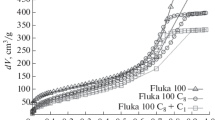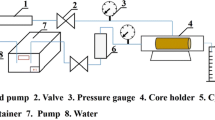Abstract
The thermal effect on the nanofluidic behaviors in a nanoporous silica gel is investigated experimentally. When a nanoporous silica gel is modified by silyl groups, its surface becomes hydrophobic. A sufficiently high external pressure must be applied to overcome the capillary effect; otherwise liquid infiltration could not occur. The formation and the disappearance of a solid–liquid interface are employed for energy storage or dissipation. When the hydrophobic surface of nanoporous silica gel is decomposed at various temperatures, the organic surface layers can be deactivated. As a result, the degree of hydrophobicity, which can be measured by the liquid infiltration pressure, is lowered. The infiltration and defiltration behaviors of liquid are dependent on the controlled by the decomposition-treatment temperature.
Similar content being viewed by others
References
S. Polarz and B. Smarsly: Nanoporous Materials. J. Nanosci. Nanotechnol. 2, 581 (2002).
Martin T., Lefevre B., Brunel D., et al., Dissipative water intrusion in hydrophobic MCM-41 type materials. Chem. Commun., 24 (2002).
Han A., Punyamurtula V.K. and Qiao Y. Effects of cation size on infiltration and defiltration pressures of a MCM-41. Appl. Phys. Lett., 92, 153117, 1 (2008).
J. C. Riviere and S. Myhra: Handbook of Surface and Interface Analysis. CRC Press (1998).
G. Lu and T. Yu: Energy Absorption of Structures and Materials. CRC Press (2003).
Karami and S. Rohani: Progressive strategies for nanozeolite Y synthesis: A review. Rev. Chem. Eng. 23, 1 (2007).
Zukal: Recent trends in the synthesis of nanoporous materials. Chem. Listy 101, 208 (2007).
M. Yang and K. J. Chao: Functionalization of molecularly templated mesoporous silica. J. Chinese Chem. Soc. 49, 883 (2002).
Han and Y. Qiao: Controlling infiltration pressure of a nanoporous silica gel via surface treatment. Chem. Lett. 36, 882 (2007).
Han and Y. Qiao: Effects of surface treatment of a MCM-41 on motions of confined liquids. J. Phys. D – Appl. Phys. 40, 5743 (2007).
M. H. Lim and A. Stein: Comparative studies of grafting and direct syntheses of inorganic-organic hybrid mesoporous materials. Chem. Mater. 11, 3285 (1999).
J. A. Fay: Fluid Mechanics. MIT Press (1994).
Author information
Authors and Affiliations
Rights and permissions
About this article
Cite this article
Qiao, Y., Sun, Z., Lu, W. et al. Temperature Variation in Energy Absorption System Functionalized by Nanomaterials. MRS Online Proceedings Library 1224, 1017 (2009). https://doi.org/10.1557/PROC-1224-FF10-17
Received:
Accepted:
Published:
DOI: https://doi.org/10.1557/PROC-1224-FF10-17




